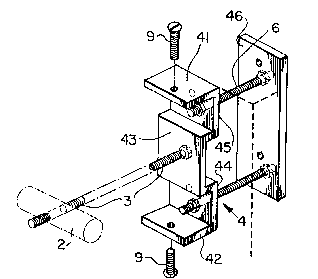Some of the information on this Web page has been provided by external sources. The Government of Canada is not responsible for the accuracy, reliability or currency of the information supplied by external sources. Users wishing to rely upon this information should consult directly with the source of the information. Content provided by external sources is not subject to official languages, privacy and accessibility requirements.
Any discrepancies in the text and image of the Claims and Abstract are due to differing posting times. Text of the Claims and Abstract are posted:
| (12) Patent: | (11) CA 2010740 |
|---|---|
| (54) English Title: | POST BEAM LOCK CONNECTION |
| (54) French Title: | CONNEXION A VERROUILLAGE POUTRE-POTEAU |
| Status: | Term Expired - Post Grant Beyond Limit |
| (51) International Patent Classification (IPC): |
|
|---|---|
| (72) Inventors : |
|
| (73) Owners : |
|
| (71) Applicants : | |
| (74) Agent: | MOFFAT & CO. |
| (74) Associate agent: | |
| (45) Issued: | 1994-05-10 |
| (22) Filed Date: | 1990-02-22 |
| (41) Open to Public Inspection: | 1991-08-22 |
| Examination requested: | 1990-06-26 |
| Availability of licence: | N/A |
| Dedicated to the Public: | N/A |
| (25) Language of filing: | English |
| Patent Cooperation Treaty (PCT): | No |
|---|
| (30) Application Priority Data: | None |
|---|
A B S T R A C T
A connection for securing a horizontal structural member to
a vertical structural member includes a first plate dimensioned
for attachment to the end of a horizontal member. The first
plate has an inner face apertured to accept a bolt extending
into the horizontal member, and at least one outer face apertured
to accept a bolt extending through the vertical member. The
inner and outer faces are spaced from one another sufficiently
to permit bolt heads to be contained between the members. A
second plate is provided for emplacement on the vertical member
opposite the first plate, second plate being apertured to accept
the bolts extending through the vertical member from the outer
face of first plate. Bolts and bolt securing means connect the
first and second plates together on opposite sides of a vertical
member. A bolt extends into the horizontal member to connect the
first plate thereto.
Note: Claims are shown in the official language in which they were submitted.
Note: Descriptions are shown in the official language in which they were submitted.

2024-08-01:As part of the Next Generation Patents (NGP) transition, the Canadian Patents Database (CPD) now contains a more detailed Event History, which replicates the Event Log of our new back-office solution.
Please note that "Inactive:" events refers to events no longer in use in our new back-office solution.
For a clearer understanding of the status of the application/patent presented on this page, the site Disclaimer , as well as the definitions for Patent , Event History , Maintenance Fee and Payment History should be consulted.
| Description | Date |
|---|---|
| Inactive: Expired (new Act pat) | 2010-02-22 |
| Inactive: Entity size changed | 2007-02-16 |
| Inactive: IPC from MCD | 2006-03-11 |
| Inactive: Entity size changed | 2002-02-13 |
| Grant by Issuance | 1994-05-10 |
| Application Published (Open to Public Inspection) | 1991-08-22 |
| Request for Examination Requirements Determined Compliant | 1990-06-26 |
| All Requirements for Examination Determined Compliant | 1990-06-26 |
| Small Entity Declaration Determined Compliant | 1990-02-22 |
There is no abandonment history.
| Fee Type | Anniversary Year | Due Date | Paid Date |
|---|---|---|---|
| MF (patent, 8th anniv.) - small | 1998-02-23 | 1998-02-04 | |
| MF (patent, 9th anniv.) - small | 1999-02-22 | 1999-02-03 | |
| MF (patent, 10th anniv.) - small | 2000-02-22 | 2000-01-21 | |
| MF (patent, 11th anniv.) - small | 2001-02-22 | 2001-02-09 | |
| MF (patent, 12th anniv.) - standard | 2002-02-22 | 2002-02-06 | |
| MF (patent, 13th anniv.) - standard | 2003-02-24 | 2003-02-19 | |
| MF (patent, 14th anniv.) - standard | 2004-02-23 | 2004-02-16 | |
| MF (patent, 15th anniv.) - standard | 2005-02-22 | 2005-02-09 | |
| MF (patent, 16th anniv.) - standard | 2006-02-22 | 2006-02-16 | |
| MF (patent, 17th anniv.) - small | 2007-02-22 | 2007-02-16 | |
| MF (patent, 18th anniv.) - small | 2008-02-22 | 2008-02-07 | |
| MF (patent, 19th anniv.) - small | 2009-02-23 | 2009-02-18 |
Note: Records showing the ownership history in alphabetical order.
| Current Owners on Record |
|---|
| WOLF WILBERT |
| Past Owners on Record |
|---|
| None |